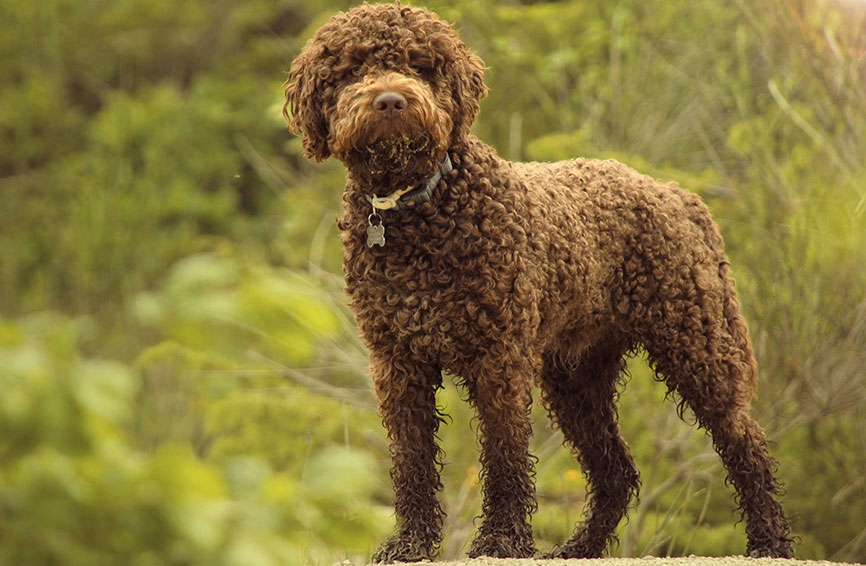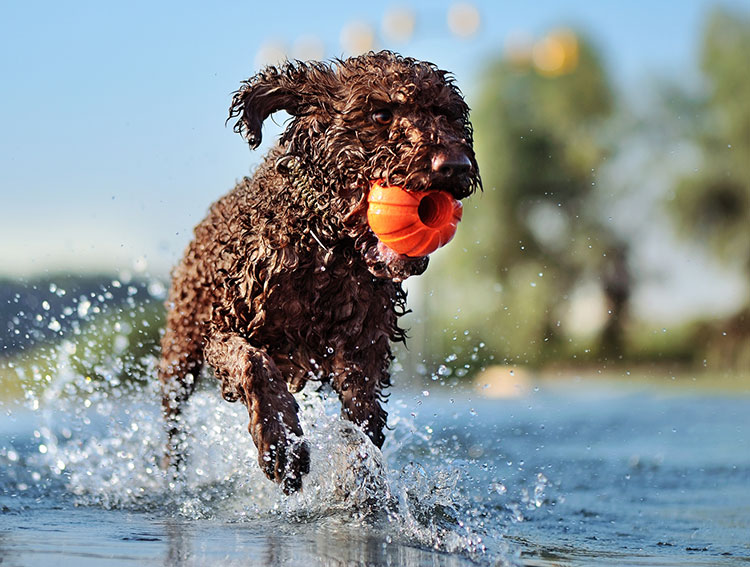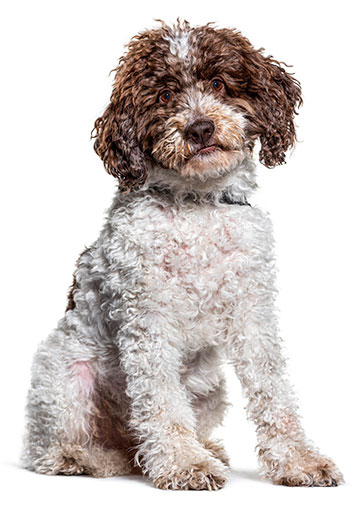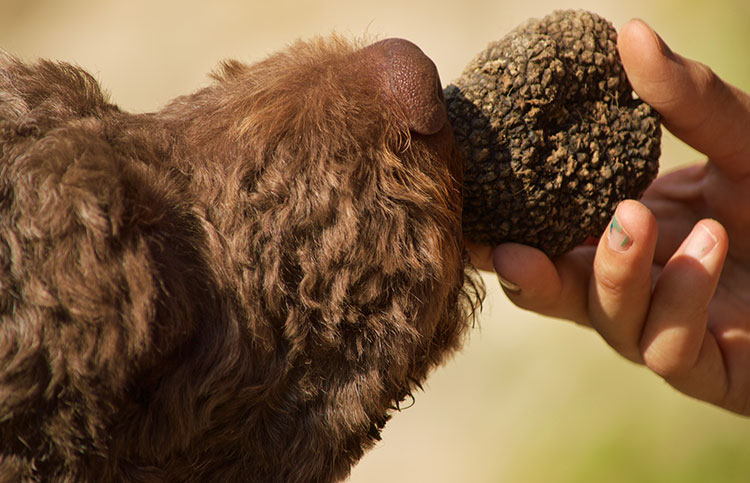Table of Contents
Introduction to Lagotto Romagnolos
The Lagotto Romagnolo is an affectionate, even-tempered, and unique dog breed distinguished by its curly mop of a coat. “Lagotto” comes from the Italian word for lake, and “Romagnolo ” refers to the Romagna region in Italy. This lake dog almost looks like a plush stuffed animal but is actually a prized companion for sniffing out truffles. Dogs from this breed are lively, loyal, and love people. They are the only modern dogs explicitly bred for truffle hunting, and although their coats require a bit of maintenance, they are also among the most hypoallergenic dogs.
Are you curious to learn more about these lake dogs from Romagna? Read this Healthy Paws breed guide to learn if a Lagotto Romagnolo is the right dog for you!
Size of Lagotto Romagnolos
The average weight of an adult male Lagotto Romagnolo is 28.5 to 35 pounds, and the average female weight is 24 to 31 pounds. Males stand 17 to 19 inches tall, and females are 16 to 18 inches tall.
Here’s how big you can expect your Lagotto Romagnolo to get as the dog grows from puppyhood to adulthood. Female weights are on the low end of these ranges, and male weights are on the high end.
| Weight Chart | 3 months | 6 months | 9 months | 12 months |
| Female and male Lagotto Romagnolos | 10 – 11 lbs. | 18 – 24 lbs. | 20 – 28 lbs. | 22 – 31 lbs. |
Characteristics of Lagotto Romagnolos
The general temperament of a Lagotto Romagnolo is playful, affectionate, and intelligent. These are highly trainable dogs that aren’t very demanding and don’t shed much. They are relatively adaptable dogs that can live in various environments and do well with kids and pets when socialized from an early age. You’ll love the versatility of the Lagotto Romagnolo once you get to know your pup and likely find a great balance between an active lifestyle and couch cuddle time together.
As you get to know a Lagotto Romagnolo’s personality, here’s what you can expect based on their breed characteristics:
| Breed Characteristic | Level (High, Medium, Low) |
| Affectionate with People | High |
| Good with Kids | Medium |
| Good with Pets | High |
| Need for Exercise | Medium |
| Energy Level | Medium |
| Intelligence Level | High |
| Able to Be Trained | High |
| Amount of Barking | Medium |
| Amount of Shedding | Low |
History of Lagotto Romagnolos
The history of the Lagotto Romagnolo breed takes us back to Italy during the Renaissance period when the dogs were bred to be waterfowl retrievers. Historians believe they originally came from the Romagna region of the country, which is now known as Emilia-Romagna. The dogs worked in the marshlands of Italy and had a fantastic sense of smell. In the Italian countryside, Lagotto Romagnolos were used to sniff out truffles, an expensive delicacy that is challenging for us humans to find on our own. The powerful and rugged dogs are sometimes sent to special schools to train them to hunt truffles.
The breed waned in popularity and was at risk of extinction in the 1970s. However, people who loved these dogs revived the breed to thrive today. It is among the newer dog breeds recognized by the American Kennel Club, only in 2015.
Lagotto Romagnolo Standard Information
There are certain standards by which Lagotto Romagnolos are judged and compared to each other by dog breeders and in dog shows and competitions. This medium-sized dog is well-proportioned, has a dense and curly coat of wooly texture, and has an attitude of great endurance and strength.
Here is an overview of the breed standard information for Lagotto Romagnolos:
Head:
- Broad, blunted wedge head
- Somewhat arched skull
- Nasal bone is straight
- Strong lower jaw
- Teeth meet in scissors or level bite
- Triangular ears with rounded tips
Neck, Topline, Body:
- Strong, muscular, thick, and oval neck
- Extremely powerful muscles
- Body is square, compact, and strong
- Ribcage is slightly narrowed in front
- Tail tapers from base to end
Forequarters:
- Shoulder blades are long and well-laid back
- Long forearm with compact, oval bone
- Pads have hard soles
- Nails are curved and white to dark brown in color
Hindquarters:
- Upper thigh is slightly longer than the shoulder
- Hock joint is well let down, wide, and strong
- Hind feet are slightly oval, webbed, and compact
- Toes of back feet are less arched than the forefeet
Coat:
- Skin is thin, firm, and close-fitting
- Wooly texture hair that is semi-rough on the surface
- Topcoat is thick and undercoat visible
- Skull and cheeks covered in thick hair
Color:
- Off-white solid color, white with brown or orange patches, brown roan, orange roan, orange, brown, or sable in different shades with or without white
- Tan markings are allowed
Gait:
- Energetic, lively, balanced trot
- Movement with distinction and nobility
- Back remains firm with no tendency to roll
Caring for Lagotto Romagnolos
Lagotto Romagnolos are not typically aggressive dogs and do well with kids and pets they know well. They protect their territory and make decent watchdogs because they bark at unexpected activity. These high-energy sporting dogs need plenty of exercise but love having some low-key chill time at the end of the day, too.
Here are some general tips for taking the best care of a Lagotto Romagnolo:
Best Living Environments:
- Houses with a yard for outdoor playtime
- Plenty of time with family members indoors
- Easy access to the outdoors
Type of Exercise:
- Time to run around in an enclosed yard
- Social time in a dog park
- Long walks with family members
- Running up to 2-3 miles with an adult
- Hiking for up to a half-day hike
- Hunting outings
Mental Enrichment:
- Games of fetch
- Hide-and-seek games
- Activities that engage the dog’s keen sense of smell
Training Strategies:
- Relatively easy to train this intelligent breed
- Independent-minded breed, so train with patience and persistence
- Agility and obedience training focused on dog sports
Grooming Tips:
- Brush the coat several days per week
- Bathe about once a month
- Trim the coat regularly to keep it manageable
- Brush teeth daily
- Trim nails about every month
- Clean ears weekly to prevent infections
Common Health Problems of Lagotto Romagnolos
Lagotto Romagnolo is a breed with an excellent life expectancy of 15 to 17 years. They are generally healthy dogs but still have certain medical conditions to which they are predisposed.
These are some of the most common health issues that arise with Lagotto Romagnolos:
- Hip dysplasia
- Elbow dysplasia
- Storage disease (inherited metabolic disorder)
- Epilepsy
- Cerebellar ataxia (neurological condition)
- Neuroaxonal dystrophy (central nervous system disorder)
- Kidney stones
If you choose to purchase a dog from a breeder, make sure that you choose a reputable one who prioritizes responsible breeding practices and screens for diseases that this breed is prone to.
Diet and Nutrition for Lagotto Romagnolos
Adult Lagotto Romagnolos require about two to three cups of dry dog food per day. This total amount should be divided into two feedings, morning and night. A high-quality commercial dog food is recommended, such as diets made by Purina, Royal Canin, or Science Diet.
Where to Adopt or Purchase Lagotto Romagnolos
The national breed club for Lagotto Romagnolos is the Lagotto Romagnolo Club of America, which provides breeder listings, rescue resources, and general breed information on its website. To adopt a Lagotto Romagnolo needing a loving home, consider the nonprofit Lagotto Romagnolo Dog Rescue or other local organizations in your area.
Related Breeds
The Lagotto Romagnolo is a very unique dog breed, but if you like the size of this dog, then you might also be interested to learn about these dog breeds, too:
- American Eskimo
- Staffordshire bull terrier
- Imo-Inu
- Puli
If a water dog is what you are looking for, the Portuguese water dog and the Spanish water dog are other breeds to consider before adopting or purchasing a new pet.
Pet Insurance for Lagotto Romagnolos
To help your Lagotto Romagnolo live a long and healthy life, you need Healthy Paws on your side. With our dog insurance plan, you can take your Lagotto Romagnolo to any licensed vet you trust and never sacrifice your pet’s care because of financial concerns.
Our Lagotto Romagnolo insurance covers new illnesses, accidents, emergency care, breed-specific conditions, hereditary conditions, cancer, and alternative care. We are the top-rated pet insurance plan in the country and have over 560,000 pets enrolled. With flexible deductible and premium options, plus no enrollment or administrative fees, we are here to help you save money on expensive vet bills while getting your Lagotto Romagnolo the necessary care.
Request your online pet insurance quote on our website today and feel confident with every adventure that your Lagotto Romagnolo gets into!













